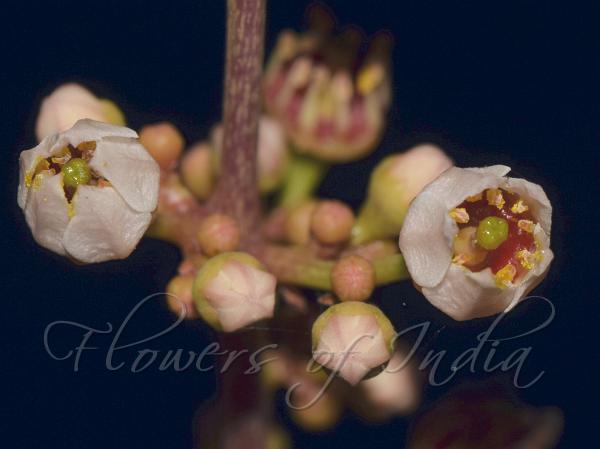|
| South Indian Olibanum |
|

|

| File size | 498102 |
| Original date | 3/25/22 8:48 PM |
| Resolution | x |
| Flash | Flash fired, return detected |
| Focal length | 90.0mm |
| Exposure time | 1/200s |
| Aperture | 25.0 |
| Focus Distance | |
| Metering Mode | $meteringMode |
| Camera make | NIKON CORPORATION |
| Camera model | NIKON D5300 |
| Sensor type |
|
|
|
|
Photo: |
Botanical name: Boswellia ovalifoliolata Family: Burseraceae (Torchwood family)
South Indian Olibanum is a narrowly endemic and
endangered deciduous tree. The leaves are compound and crowded at the
ends of branches. The flowers are borne in branched panicles at the
ends of the branches. Each branch produces 8-10 inflorescences and each
inflorescence produces about 30 flowers over a period of 5-14 days.
The flowers are stalked, greenish-white, 6 mm long, 5 mm across, mildly
fragrant, cup-shaped, bisexual. Petals are 5, white, free,
overlapping, 5 mm long and erect. Sepals are 5, minute, basally fused,
overlapping, light green, lightly velvet-hairy outside and persistent
without any further growth during post-fertilization stage in fruited
flowers. Stamens are inserted outside a fleshy annular pinkish-red
nectary disc which is present outside the ovary at the flower base.
They are 10 arranged in two whorls. The pistil is clearly distinguished
into ovary, style and stigma. The ovary is superior, trilocular, each
locule with two drooping ovules borne on axile placentation. The style
is light pink at base and dark green above, 4 mm long and trilobed. The
stigma is short, head-like, shiny. South Indian Olibanum is found only
in a small region of Eastern Ghats in Andhra Pradesh.
Medicinal uses: The plant is over exploited
for its medicinal uses. The fresh leaf juice used to prevent throat
ulcers. Decoction of the stem bark 10-25 ml per day reduces rheumatic
pains. The gum obtained from the trunk which is highly medicated. This
gum is sold in the local market by the native tribals as Konda sambrani
in Telugu language. Small lumps of fresh light yellow
colored liquid
oozes out from the stem and hardens on exposure. Shade dried gum is
powdered dissolved in water and mixed with curd and given orally to
cure amoebic dysentery.
The plant is over exploited
for its medicinal uses. The fresh leaf juice used to prevent throat
ulcers. Decoction of the stem bark 10-25 ml per day reduces rheumatic
pains. The gum obtained from the trunk which is highly medicated. This
gum is sold in the local market by the native tribals as Konda sambrani
in Telugu language. Small lumps of fresh light yellow
colored liquid
oozes out from the stem and hardens on exposure. Shade dried gum is
powdered dissolved in water and mixed with curd and given orally to
cure amoebic dysentery.
Medicinal uses:
 The plant is over exploited
for its medicinal uses. The fresh leaf juice used to prevent throat
ulcers. Decoction of the stem bark 10-25 ml per day reduces rheumatic
pains. The gum obtained from the trunk which is highly medicated. This
gum is sold in the local market by the native tribals as Konda sambrani
in Telugu language. Small lumps of fresh light yellow
colored liquid
oozes out from the stem and hardens on exposure. Shade dried gum is
powdered dissolved in water and mixed with curd and given orally to
cure amoebic dysentery.
The plant is over exploited
for its medicinal uses. The fresh leaf juice used to prevent throat
ulcers. Decoction of the stem bark 10-25 ml per day reduces rheumatic
pains. The gum obtained from the trunk which is highly medicated. This
gum is sold in the local market by the native tribals as Konda sambrani
in Telugu language. Small lumps of fresh light yellow
colored liquid
oozes out from the stem and hardens on exposure. Shade dried gum is
powdered dissolved in water and mixed with curd and given orally to
cure amoebic dysentery. | Identification credit: Ashutosh Sharma | Photographed in FRLHT/TDU Botanical Garden, Bengalur. |
• Is this flower misidentified? If yes,